Administering FMLA can be risky business — but if properly understood and used, it can work to your advantage.
Are you familiar with the ins and outs of FMLA? Does your organization have a thorough policy that covers all of the situations you might face in administering FMLA? If an employee tries to take advantage of FMLA, would you know how to handle it? Don't get caught unprepared. Your organization could end up in a tangled legal web if you're not familiar with
the intricacies of FMLA. With every new court case, the FMLA becomes better defined — and sometimes more confusing.
In just one hour, you'll gain a better understanding of the FMLA, learn to eliminate FMLA confusion and explore real-life issues.
Do you know the answers to these questions?
- A husband and wife work for your organization and both request the full 12-week FMLA leave for the birth of their child. Are they both eligible for the full 12 weeks of leave?
- An employee working for you on a part-time basis requests FMLA leave. He has worked at least 1250 hours during the previous 12-month period. Is he eligible as a part-time employee?
- An employee on FMLA leave argues that you must continue paying her regular pay while she is on leave. Is she right … or are you in violation of the FMLA?
- An employee with an absenteeism problem continues to claim FMLA leave. Is this abuse by the individual or is he eligible for FMLA leave?
- An employee requests several weeks of FMLA for a serious health condition. Your organization requires that the employee provide a medical certificate from the healthcare provider and the employee balks. Does your organization have the right to require a medical certificate under the FMLA?
- An employee requests FMLA leave; however, she wants to take unpaid leave and doesn't want her accrued vacation time used as part of the leave. Can your organization force her to use her paid vacation leave and count it toward FMLA leave?
If you answered "I'm not sure" or "I don't know" to even one question, then you need to attend this program to keep yourself and your organization out of FMLA trouble. This powerful one-hour webinar is a worthwhile investment that could end up saving you thousands of dollars in the long run.
Don't just assume that you're doing it right or that you know enough to get by. Get a true understanding of the law and be confident that your organization and its policies are fair, compliant and consistent.
You and your entire organization can benefit from this exciting and informative one-hour course. Don't miss out — get great training that could save you a great deal of money in the years to come!
